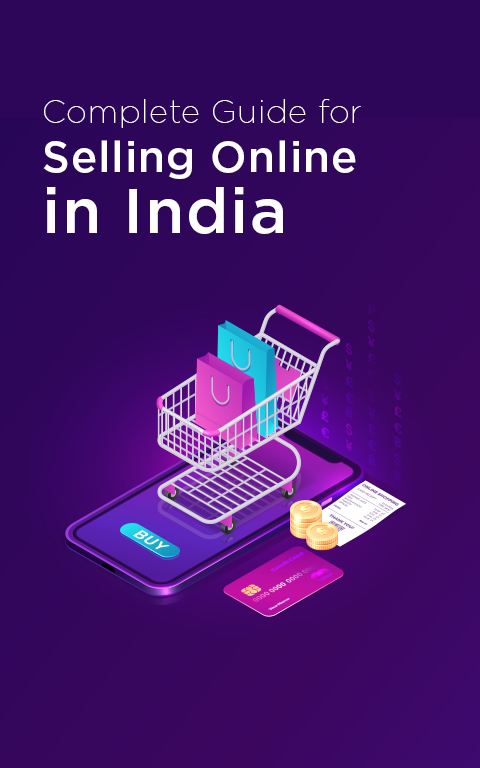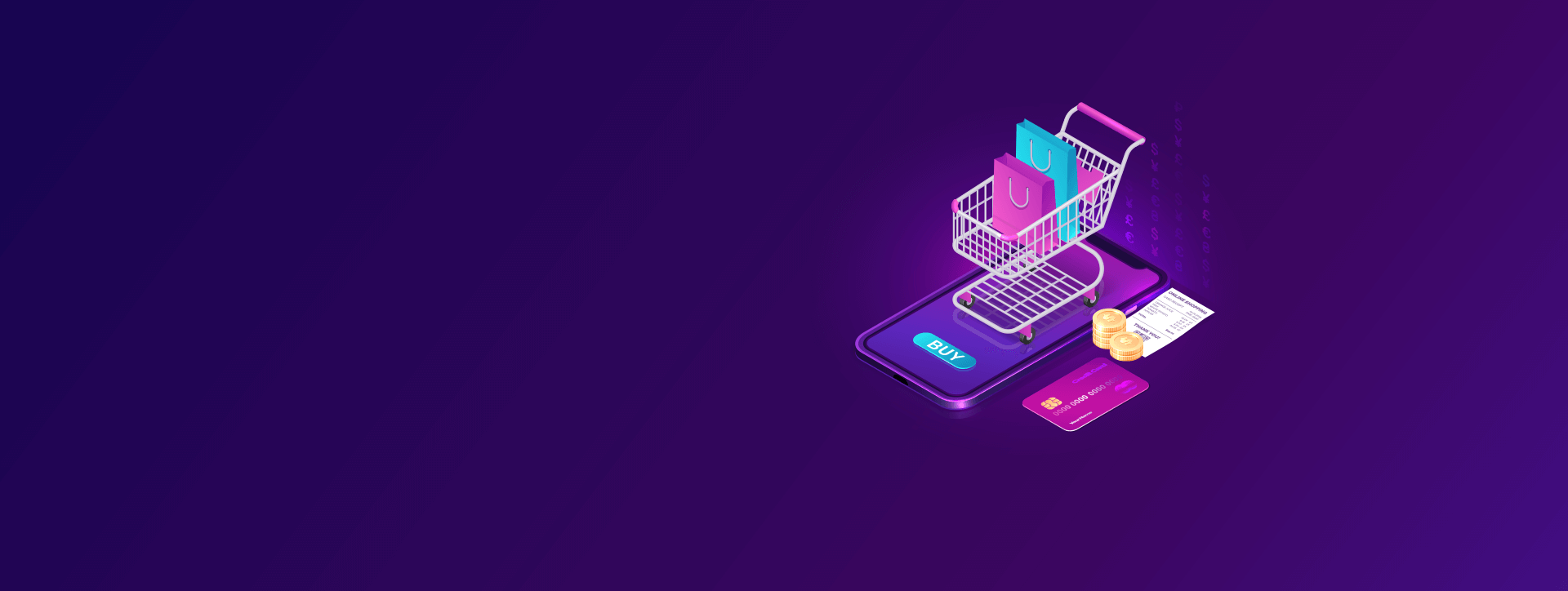Introduction
The growth of E-Commerce in India is booming, with the evolution of 4G and the Digital India movement creating a huge spike in smartphone users. It is estimated that by 2021 there will be over 829 million smartphone users in India & year on year, our e-commerce growth rate will be at 51%.
Since the pandemic, the stores’ footfall has completely converted into website traffic and almost every retailer today is ready to make the switch to digital mediums and e-commerce platforms.
To sell your products online, there are two ways to do so:
- Selling on Marketplace
- Building your ecommerce website


Selling On Marketplace
What are Marketplaces?
Online marketplaces such as Websites & Apps are platforms for 3rd party vendors to sell their products.
This is not only beneficial from a customer standpoint where they get to compare and choose between products from multiple brands but is also advantageous for the sellers.
The sellers cannot benefit from the market place if they do not have their website to showcase their products. This gives a flexible market opportunity at a relatively lower cost.
Though marketplaces charge commission and have a fixed fee structure associated with selling products, they take away the burden of shipping, delivering, payments from the sellers, and open doors to a huge customer base right from the onset of their business. Generally, these marketplaces have millions of visitors coming to check their products and the sellers can leverage this customer base into exponential sales easily.
With the rise in e-commerce platforms and digital dependency, there are numerous eCommerce marketplaces here to solve the seller’s day to day problems of dealing with offline store management. A few of the top marketplaces in India are:
1
Amazon India
2
Flipkart India
Amazon launched its marketplace Amazon. in, in June 2013 intending to change the way how buyers and sellers transact. Since then, Amazon has been catering services to almost 5.5lakh total sellers from all around India.
Why sell on Amazon?
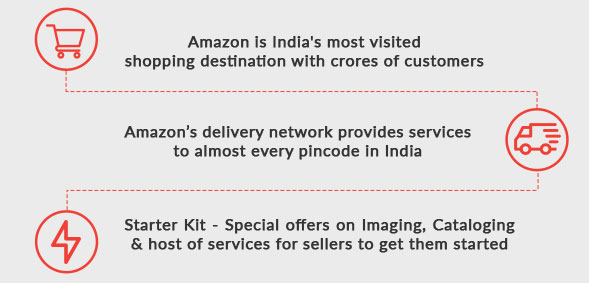
Selling on Amazon is very simple. With a few quick steps mentioned below one would be able to sell products on the site:
- List your products on Amazon and become a seller. It takes only 15 minutes to set up the seller account, post which you can enjoy a host of selling benefits from Amazon.
- Amazon provides a variety of options to help kickstart your business starting from advertising on their platform to receiving seller support.
- Amazon collaborates with logistics partners such as Easy Ship and FBA, who ease the burden of shipping and delivery of the sellers. Additionally, you as a seller, can also deliver the product yourself to nearby pin codes and unlock Local Shops benefits.
- Once you begin receiving sales, funds from your sales will be deposited in your bank account every 7 days.
Read our blog ‘Five Step Guide to Selling Online on Amazon India’ to know more
One of India’s leading platforms for selling online is Flipkart. It allows manufacturers, vendors, suppliers to sell their products online with minimum investment. They focus on empowering sellers across India by offering exclusive seller workshops, training, and seller support.
Why sell on Flipkart?
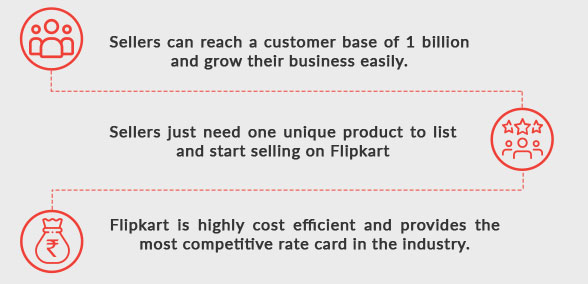
You just need 3 things to become a seller on this platform
- At least 1 unique product to sell
- GSTIN details are required to start selling your products online
- A copy of a cancelled cheque of your bank account is compulsory while registering.
- Once you begin receiving sales, funds from your sales will be deposited in your bank account every 7 days.
3
Paytm Mall
4
Snapdeal
Paytm is India’s largest mobile commerce platform which offers mobile-first, easy setup and chat options to bargain between sellers and customers. Paytm which began its journey by offering online mobile and DTH recharging service is now a fully functional ecommerce platform offering a range of products.
Why sell on Paytm?
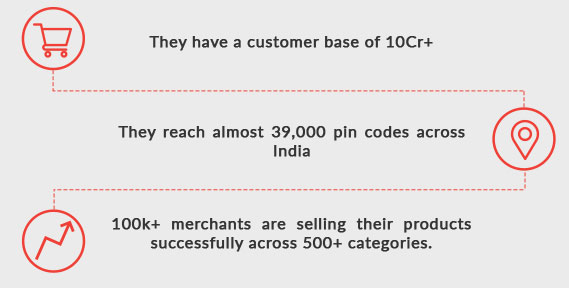
4 easy steps to start selling on Paytm?
- Signup with your Paytm credentials
- Submit, and verify your name, email address and phone number
- Submit information and documents like bank account details, GST, etc.
- Update catalog and begin selling online
Delivering to more than 3000 cities and towns across India, Snapdeal sells almost over 30 million products across 800 diverse categories and reaches out to more than 4 crore happy customers.
Why Snapdeal?
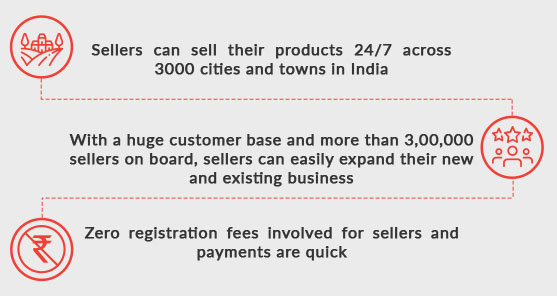
Simple steps to sell on Snapdeal
- Register your business for free and list your products on the website
- Get all documentation and cataloging of products done with the help of a professional service provider
- Once your products are listed, they will be visible to millions of customers across India.
- Once the orders are fulfilled, the sellers will receive their payment easily.
Selling From Own Website
Starting your ecommerce website can be challenging, but it has innumerable benefits that are listed below :
To sell your products online, there are two ways to do so:
- Helps Build your Brand
- Build your own customer base
- Stand out from the competition
- Easy Retargeting
We have a list of e-commerce dedicated platforms where you can build your own store with easy integration to payment & shipment options.

Ecommerce Platforms

Shopify is one of the easiest platforms to set up an ecommerce website. It’s perfect for Small and Mid-size enterprises(SMEs). Plans start from just $9 to $299 Per month.

It is specifically designed for those who have a WordPress website or those who plan to build their website on WordPress. Woocommerce is the best plugin to transform your website into an e-commerce website. It's populated with a huge array of customizable options and is also SEO optimized. It's the best for small to medium size e-commerce.

One of the best platforms to customize your website based on your preferences, It offers a large number of extensions and 3rd-party integrations to give consumers a unique experience. It also helps with Search Engine Optimisation(SEO), with a large community to support best suited for Enterprise-level Ecommerce with developer resources.

To set-up your online stores easily BigCommerce provides users with various customizable templates. It’s best for beginners to advanced e-commerce shop owners. Plans start from $29 to $248 per month.

Wix is a new e-commerce website builder. It provides easy to use creative templates. Plans start from $17 to $25 per month. Its best suited for beginners and small e-commerce owners(less than 100 products)
Important Metrics Comparison
| Platform | Ease of Use 5 |
Load Time in secs |
Avg SEO Traffic |
Mobile Speed 100 |
Design&Themes 5 |
Visual Design 5 |
Mobile \UX 100 |
|---|---|---|---|---|---|---|---|
| Shopify | 4.8 | 1.3 | 11717 | 63 | 4 | 5 | 97 |
| Magneto | 2.9 | 4.8 | 19408 | 39 | 3.7 | 5 | 96 |
| Woocommerce | 3.3 | 3.4 | 72968 | 42 | 4.3 | 3 | 97 |
| Bigcommerce | 4.5/td> | 2.2 | 33626 | 63 | 3.8 | 5 | 94 |
| Wix | 2.6 | 3.2 | 543 | 69 | 4.7 | 5 | 92 |
Website Design & Structure
Homepage Design & Structure
The website design should be such that it’s easier for the user to navigate. The following points can act as a guide when designing a website
- Keep the website visitor in mind
Each and every single detail of your website from logo, product images, newsletters to contact forms could potentially contribute to a user’s decision to buy a product. - Simple Website Design
Are easy to load in all kinds of devices and help users to navigate easily. - Quality photos
High quality product images and videos will enhance your ecommerce website design. - Include reviews and/or testimonials
Effective Ecommerce web design plan involves adding product-specific reviews right under each individual product’s description to help users know more about the product which in turn increase the trust value on websites.
Homepage design and structure play a vital role in conversions. Every product needs to be grouped under a commonly known category, which needs to be linked to the homepage, thts makes it easier for the user to find. The Homepage section needs to be updated regularly, to increase the engagement ratio. Also, the best selling products section should have a permanent section on the homepage.
- Featured Products
- Newly Arrived Products
- Top Seling Products
- Customer Testimonials
- Blogs
Product Photography
Payment Gateway Integration
To satisfy all kinds of customers, the sellers must find the ultimate way to showcase their products. That’s why e-commerce product photographers play a vital role in selling a product.
- All angles of a product photo need to be listed.
- Prefer white background.
- Zoom feature needs to be enabled.
- Apparel products with model can be added.
Here is the list of top photographers who will help in capturing your e-commerce products to perfection.
- Radiance Vision
- Photuwala’s Studio
- Art Pixel Photography
- DigitalStudio
There are two types of payment gateways which can be integrated into a website
- Integrated Payment Gateway
Serving the customer in your own ecommerce domain without sending the user to another domain for payment alone. - Hosted Payment Gateway
Redirecting users to a different domain(payment domain) for payment alone. After successful payment, users will be redirected to your ecommerce domain.
For those who are going to start an ecommerce website, a hosted payment gateway works best one as it is easy to implement compared to an integrated payment gateway, which needs professional programmer help and is usually more expensive.
All payment options that need to be enabled, to make the payment easier are:
- Credit/Debit Card
- Netbanking
- UPI (Google pay, Paytm, Phonepe, BHIM)
- Wallet(Phonepe, Paytm, freecharge, OLA Money, airtel money etc)
Top Hosted Payment Gateways in India

Multiple currency processing, 200+ maximum payment options, Apple & iOS Mobile App Integration is available, CCAvenue checkout, iframe integration is also available.

It is easy to integrate with Zero initial setup charges & Zero annual maintenance charges. App-ready with mobile SDKs for Android and iOS platforms. All payment options are available.

Razorpay does not support multi-currency. Supports 100+ modes of payment options. Zero initial setup fee & Zero annual maintenance fee.
- FedEx.
- DTDC.
- ECOM Express.
- Blue Dart.
- Delhivery.
- DHL
For newcomers in the Ecommerce market, choosing a shipping service might not be as easy. Evaluating the following factors over a period of time will help us in serving better. Always validate with customer, measure delivery ratio, zone wise performance, turn around time and price.

It’s best to choose an automated solution that uses a combination of these logistics services to serve across all areas in India and without spending too much. Shiprocket is the answer to your call. It has tie-ups with DHL, eCOM Express, Aramex, DTDC, and First Flight depending on the service area, and the price is automatically integrated with your system, giving you the best option depending on the delivery pincode.
ECommerce Strategy & Planning
Before drafting the plan for the first digital campaign, we need to do the following:
- Market Research - Read the market
- Analyse your competitors
- Brand Positioning
- Marketing Strategy

Market Research
Competitor Analysis:
Market research typically involves understanding the marketplace of our product. Broadly speaking, for digital marketing it could be categorized into the following steps: Observing the market, Understanding USP of our product and Analysing the competitors, Know who your audience is and what kind of content it consumes. This information helps in building a better digital approach to marketing our product.
As every other business is going online, we need to closely watch how our competitors are constantly engaging with the customers. This could be looked at different channels such as their organic posts, website content & traffic they receive, keywords they use, how much they spend, communication used in their google ads & social media posts. We have a list of tools for competitor analysis such as Facebook Ads library, Google trends, SEM rush, Uber suggest & lot more. Among them, only a few tools are free to use.
Conducting competitor analysis, helps us stand out from competitors & also helps us to set benchmarks. For example, if you are launching a haircare product you probably need to benchmark on leading industry influencers like Head & Shoulders.
Also never forget to choose the right competitors who are going to directly compete with your product. Only then, start your research.
Brand Positioning
Digital Marketing Strategy
This happens to be an important question to ask yourself when you are new to the market and are trying to figure out how to stand out from the competitors. In some other cases, when you are about to launch a new product & how you want to position the new product to stand out from your previous product or competitor product.
The most part of brand positioning is done at the product planning/development stage. We just need to bring out those characters during marketing communication & stick tangent with the core audience.
You can’t skip previous steps to jump into this part. Planning a digital strategy involves an extensive understanding of the product and its market place. Especially for e-commerce, we need to carefully plot the customers' actions at every interaction. Whether selling through your e-commerce site or selling through Marketplace, we can’t always convert the users on their first visit. So it is always recommended to do a full-funnel marketing approach.
What is a full-funnel marketing strategy?
Marketing Strategy for Ecommerce
- Optimizing your ecommerce site for organic listing
Most of the Ecomm advertisers pay very little attention towards their organic listing & more they focus on social and paid ads. This obviously requires much effort upfront but once you start to rank, you will have your traffic running with zero fuel cost. At social beat, we create compelling contents for every stage of the customer journey on both website & social media. Multilingual content can also be created to reach your customers across geographic locations. 22 Languages By the time you create your website, we should have created strong social channels to grab instant audiences to your website - Create relevant contents that educates user
Creating custom content is the best way to connect with your audience. It is always recommended to create video contents, people are actually looking for video contents rather than reading time consuming text contents for better visual experience. For Ecommerce the different verticals that we can explore for creating impactful content that drives consideration in users may include
Product Features Videos:
- Pre Launch Videos
- Highlight product USP
How to Videos:
- Product walkthrough - Brand Verification, Installation & integration
- How a pro-user uses our product
- How to maintain/service your product
Tips/Tricks:
- Communicate tips that helps user to choose best product for them
- About common mistakes & Misinterpretations
In COVID19 situation, these contents are really helping the brands to connect their customers. Amplifying them through paid promotions could also help in brand lift
- Flawless user experience & integration
If we are looking at building Ecommerce platforms, we must ensure that the website is more professional and user friendly. It should provide all relevant product information, easy to navigate, build the trust factors by encouraging user reviews and most importantly have be easy payment & checkout options. Make sure the page is more responsive and loads in less than three seconds. The best way to build your Ecommerce website, is to hire a developer and start from scratch. You can also quickly build your website with ready to go platforms like Shopify or wix within hours. - Paid Traffic
Initially to begin with you might need a customer base to do your business. The best and easiest way to drive relevant customers to your website is doing paid promotion activities across search engines, social media & Market places. To stick with Full funnel approach the channels that we can look after for ecomm brands is depicted below:

Traffic/ Promotions
Now that you have your website, marketplace or both sets upped and ready to go for the launch, next comes the most challenging part of your journey, that is being found where your customers are. Make your marketing efforts count on sales by experimenting and choosing the best activities to reach your potential buyers.

Email Marketing
Ecommerce SEO
Email marketing is the most cost-effective channel that helps to build trust and loyalty and gets you results. Reach subscribers or your business customers with engaging content, product offers, and build important relationships with them. With personalized message and genie follow-ups, increase your chances of getting more response rates.
The goal of e-commerce SEO is to organically increase your traffic and ranking to your product and product category pages to the top of the SERP (Search Engine Results Page). Using tools like Google Keyword planner or Ubersuggest, one can find out how many people are researching for the products you are offering. Rich informative content about the product with benefits, USP, site architecture, product image, reviews, and testimonials are the few must-have to achieve higher rankings on Google.
Content Marketing for Ecommerce
Ecommerce Ads
Content marketing can get you targeted traffic & sales. Tools like mention and Buzzsumo helps you to understand what people are saying the company or product that you are offering. These also help you to keep track of competitor's products. Place a product or company name on the tool and get to hear the voices of the people across social channels.
Great! Now that you have found out what people interest, likes, and dislikes are, create a solid piece of content around the topic with the phrases people are using. Publishing regularly helps you to increase traffic, social share, and further result in better ranking for product and category pages.
If you want to boost your e-commerce sales quickly, you should consider running ads for your products. Facebook Ads are one of the easiest and most effective platforms to start your paid advertising journey for your Ecommerce. Ads help your brand to reach a wider audience which otherwise would not have been possible using organic methods. Ad creative and targeting are two important pillars for successful Ecommerce campaigns. With retargeting one can reach people who have visited your store, add a product to cart, and leave without checking out.
Voice Commerce
Social Commerce
Voice Commerce is considered to be one of the latest trends in the Ecommerce space. It has completely changed the way customers shop online. Voice Commerce allows shoppers to make purchases via voice commands through smart devices. Users tell their devices what product they are looking for, and it searches through the web and gives relevant results, users can choose from recommendations and purchase directly through voice. Voice based shopping is expected to jump to $40 billion industry by 2022 – Prnewswire.

It is electronic commerce in social media platforms that has gained a huge amount of interest in the social media industry. The difference between Social media marketing and social commerce is that you drive referral-traffic from social media to store/website in social media marketing and when it comes to social commerce the entire experience of the customer from viewing a product, checkout and purchase happens without even leaving the social media site. Facebook and Instagram are the most popular Social Commerce platforms followed by Pinterest.

Track Users
Tracking users is the most essential thing for any ecommerce business. Tools like Google Analytics helps you to understand your users better. With valuable data provided by the analytics tools, create a better experience for your customers, track your marketing efforts, and learn where the product drop-offs are happening.
E-Commerce Customer Journey Mapping
Customer journey is a sequence of customers experience when engaging with a company or even a product. People rarely decide on buying something they see for the first time. The Digital era has made buying choices more complicated. One map doesn’t work for all customers, some redirects come from ads, some from friends, and others from search and blogs, and a many do not recall the brand and never visit your website again.

Customer Journey Stage
1. Awareness
Getting the customer to know about your company through ads, social media, Organic search, word of mouth, etc. Companies should primarily focus on gaining trust and creating interest among individuals.
2. Consideration
Attracting customers to your product is the only potential solution. Here’s where companies should justify the pros, cons, and prices.
3. Conversion
Convincing the customer and driving them through a smooth transaction. Make sure no one with a to-buy mindset leaves midway due to any issues. This is where customer experience comes in.
4. Retention
Companies may retain or lose customers after the first order. Some options like Emails, blogs, retargeting are used to re-engage them and make a more personalized experience for them in the future.
5. Advocacy
If retention happens well, then loyal customers will be agents and representatives of your brand.
All stages are interdependent in your customer journey. A person might move to the next stage based on his experience in each stage.
Ecommerce Analytics
Ecommerce Cart Abandonment
A famous quote says – “In god we trust; all others must bring data”. If used well, Analytics is the most powerful tool to shape your ecommerce business. It helps you with the data and insights that you can further use to develop and build a great user experience. The key here is to understand customer behavior, the path that led them to conversion, and optimize data for better sales. Analytics is also used to measure the performance of online marketing campaigns.
Cart abandon is a red alert for ecommerce store owners. It is when visitors start the checkout process and leave without completing the transaction. Examples include people who want to buy a product, add a product to the cart, abandonment because of various reasons such as heightened price at checkout, lack of trust, return policies, compulsory sign-up, no clear call-to-action & lack of customer support.
Few Industry Statistics of Shopping Cart Abandonment
- The average shopping cart abandonment rate is 68.81%
- A complicated and long checkout process is causing 27% of cart abandonments in the US alone.
- 25% of shoppers face price increments at checkout.
- 73% of online shoppers prefer free shipping.
- 35% of shoppers won’t like to create an account while purchasing something.
- 41% of shoppers are not ready to make a purchase.
Customer Lifetime value (CLV) & ROI
Customer lifetime value
Customer lifetime value helps you measure the total profit generated by the customer during their relationship with your company. This should help you understanding how likely your company will grow in forthcoming years.
LTV (LifeTime Value) – Average value of a sale X Number of Transactions X Retention Time Period CLV (Customer Lifetime Value) = Lifetime Value X Profit Margins
ROI
Your best customer spends 30 times more than your average customer - Hubspot
ROI (Return of Investment) = (Net profit/Cost of Investment) X 100
Effective analysis of the return on investment or the ROI is one of the most important metrics that one must consider while running an e-commerce business. The goal is to define a conversion, identify core conversion metrics, and experiment to increase sales numbers.

